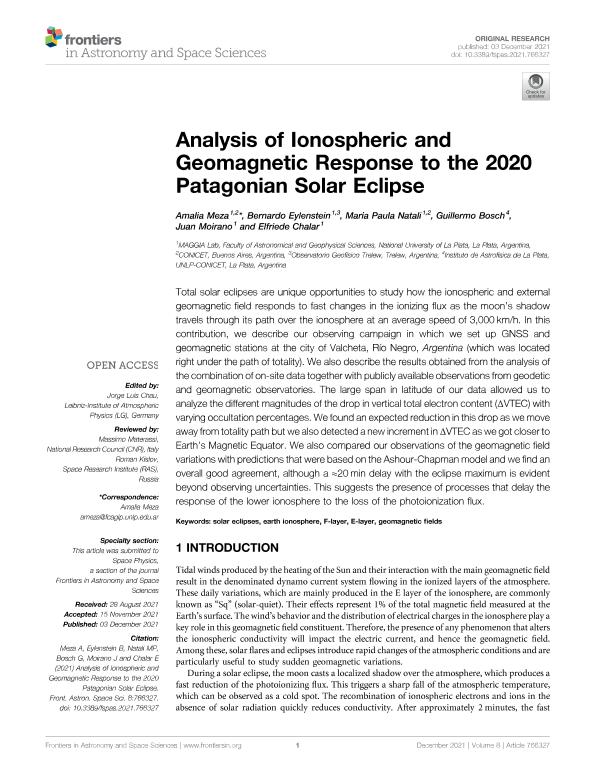Artículo
Analysis of Ionospheric and Geomagnetic Response to the 2020 Patagonian Solar Eclipse
Meza, Amalia Margarita ; Eylenstein, Bernardo Enrique; Natali, Maria Paula
; Eylenstein, Bernardo Enrique; Natali, Maria Paula ; Bosch, Guillermo Luis
; Bosch, Guillermo Luis ; Moirano, Juan Francisco
; Moirano, Juan Francisco ; Chalar, Elfriede
; Chalar, Elfriede
 ; Eylenstein, Bernardo Enrique; Natali, Maria Paula
; Eylenstein, Bernardo Enrique; Natali, Maria Paula ; Bosch, Guillermo Luis
; Bosch, Guillermo Luis ; Moirano, Juan Francisco
; Moirano, Juan Francisco ; Chalar, Elfriede
; Chalar, Elfriede
Fecha de publicación:
12/2021
Editorial:
Frontiers Media
Revista:
Frontiers in Astronomy and Space Sciences
ISSN:
2296-987X
Idioma:
Inglés
Tipo de recurso:
Artículo publicado
Clasificación temática:
Resumen
Total solar eclipses are unique opportunities to study how the ionospheric and external geomagnetic field responds to fast changes in the ionizing flux as the moon’s shadow travels through its path over the ionosphere at an average speed of 3,000 km/h. In this contribution, we describe our observing campaign in which we set up GNSS and geomagnetic stations at the city of Valcheta, Río Negro, Argentina (which was located right under the path of totality). We also describe the results obtained from the analysis of the combination of on-site data together with publicly available observations from geodetic and geomagnetic observatories. The large span in latitude of our data allowed us to analyze the different magnitudes of the drop in vertical total electron content (ΔVTEC) with varying occultation percentages. We found an expected reduction in this drop as we move away from totality path but we also detected a new increment in ΔVTEC as we got closer to Earth’s Magnetic Equator. We also compared our observations of the geomagnetic field variations with predictions that were based on the Ashour-Chapman model and we find an overall good agreement, although a ≈20 min delay with the eclipse maximum is evident beyond observing uncertainties. This suggests the presence of processes that delay the response of the lower ionosphere to the loss of the photoionization flux.
Palabras clave:
E-LAYER
,
EARTH IONOSPHERE
,
F-LAYER
,
GEOMAGNETIC FIELDS
,
SOLAR ECLIPSES
Archivos asociados
Licencia
Identificadores
Colecciones
Articulos(CCT - LA PLATA)
Articulos de CTRO.CIENTIFICO TECNOL.CONICET - LA PLATA
Articulos de CTRO.CIENTIFICO TECNOL.CONICET - LA PLATA
Articulos(IALP)
Articulos de INST.DE ASTROFISICA LA PLATA
Articulos de INST.DE ASTROFISICA LA PLATA
Citación
Meza, Amalia Margarita; Eylenstein, Bernardo Enrique; Natali, Maria Paula; Bosch, Guillermo Luis; Moirano, Juan Francisco; et al.; Analysis of Ionospheric and Geomagnetic Response to the 2020 Patagonian Solar Eclipse; Frontiers Media; Frontiers in Astronomy and Space Sciences; 8; 12-2021; 1-9
Compartir
Altmétricas



